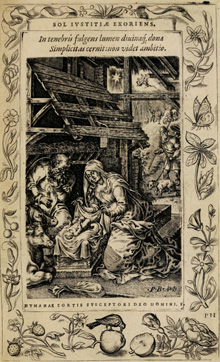
Emory scholars will consider how images, such as this early engraving from MARBL, were used to guide scriptural interpretation.
Emory University has been awarded a $175,000 Sawyer Seminar grant from the Andrew W. Mellon Foundation to support a yearlong series of seminars that will address the topic, "Visual Exegesis: Images as Instruments of Scriptural Interpretation and Hermeneutics."
Designed to foster interdisciplinary exchange, the grant will enable faculty, postdoctoral fellows, and graduate students from a variety of fields to engage in comparative inquiry through a series of seminars to be convened during the 2013-2014 academic year, says Walter Melion, Asa Griggs Candler Professor of Art History.
The Sawyer Seminar is intended to operate like a "temporary research center," he adds, "allowing scholars from many disciplines to consider how and why visual images and verbal imagery were used to help guide scriptural interpretation."
The planned series of 14 seminars will be open to any member of the Emory community, emphasizes Melion, who directed the application process and will lead a committee of seminar co-organizers during the 2012-2013 academic year as they finalize agendas and speakers.
The Sawyer Seminar Committee consists of faculty from six departments at Emory College of Arts and Sciences and Candler School of Theology, including:
- David Blumenthal, Jay and Leslie Cohen professor of Judaic studies
- Paul Courtright, professor of religion
- Cheryl Crowley, associate professor of Japanese, Russian and East Asian languages and cultures
- Dalia Judovitz, National Endowment for the Humanities professor of French and Italian
- Walter Kalaidjian, professor and chair of the English Department
- Scott Kugle, associate professor of South Asian and Islamic studies
- Joel LeMon, assistant professor of Old Testament studies
- Sara McClintock, associate professor of religion
- Elizabeth Pastan, associate professor of art history
- Vernon Robbins, professor of New Testament and comparative sacred texts
In addition to funding the seminar, the Mellon Foundation grant provides one post-doctoral fellowship and two dissertation fellowships. Recipients will be selected by the seminar's organizers in 2012-2013 for the following academic year.
The term "visual exegesis" refers to the use of images as instruments of scriptural interpretation, explains Melion, who notes that the organizers also plan to investigate how image-based exegesis operates within literary and poetic interpretation.
"It's an image-based project, but not specific to art historians — it's larger, a way for scholars in various fields who engage with images to converse across disciplinary boundaries," he says.
Exploration will begin from a vantage point of early modern Europe and then consider Christian and Jewish, Asian and Middle Eastern, Buddhist and Islamic, sacred and secular, and historical and contemporary perspectives, he adds.
"Emory is an ideal venue for this project," Melion says. "It's going to expand our field of vision, giving us the opportunity to examine the topic historically, comparatively, and multiculturally, from Jewish antiquity all the way through the 21st century."
"It's focused, but flexible enough to accommodate people working in different departments, different historical periods — everyone brings their strengths to the table."
Information about fellowship applications will be released during the fall semester and a planned future website will offer program dates and details.
Emory has received Sawyer Seminar funding on at least three earlier occasions, supporting seminars housed in African Studies, the Ethics Center, and the Center for Health, Culture and Society, according to Glenn Kellum, senior associate vice president of Development and Alumni Relations.
